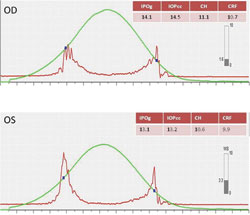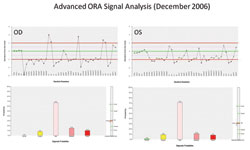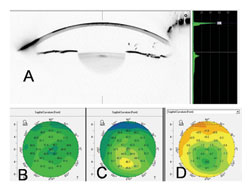Improvements made in diagnosis, treatment of early keratoconus
 Thomas John |
Advanced keratoconus with contact lens failure results in visual debilitation that often requires surgical intervention using deep or total anterior lamellar keratoplasty with retention of the patient’s endothelium or full-thickness penetrating keratoplasty with replacement of the patient’s corneal endothelium with healthy donor endothelium. However, unlike advanced keratoconus, in which the diagnosis is clinically evident, early stages of keratoconus may be more difficult to diagnose and, hence, may require advanced technological assistance for the establishment of such a diagnosis.
Once an early diagnosis of keratoconus is established, collagen cross-linking appears to be a promising and evolving corneal procedure to stabilize and possibly prevent its continued progression. This procedure is yet to be approved by the U.S. Food and Drug Administration, but it has a longer track record outside the U.S. In contrast to collagen cross-linking, PRK is an FDA-approved, well-established corneal procedure for the correction of refractive errors. Some surgeons are now exploring the combined use of corneal surface ablation with collagen cross-linking performed at the same time to treat early keratoconus. However, such procedures are in the early stages of development, and continued monitoring of these patients with long-term follow-up is essential to fully assess the safety and efficacy of these newer treatment modalities.
In this column, Dr. Ambrósio presents his clinical testing methods and calculations in confirming a diagnosis of early keratoconus and the surgical technique of combined surface ablation with collagen cross-linking to treat this condition.
Thomas John, MD
OSN Surgical Maneuvers Editor
A 21-year-old male student presented for a second opinion regarding the possibility of keratoconus. He complained of contact lens intolerance. Previous episodes of allergic conjunctivitis were reported. Uncorrected distance visual acuity was 20/25– in the right eye and 20/40 in the left eye. Manifest refraction was –0.25 –1.25 × 240 = 20/20 in the right eye and –0.75 –0.50 × 980 = 20/20 in the left eye. IOP was 12 mm Hg in both eyes. Slit-lamp and funduscopic examinations were unremarkable in both eyes.
Anterior axial (sagittal) curvature maps from Placido disk and from rotational Scheimpflug revealed inferior steepening, more pronounced in the right eye. Elevation maps for the front and back corneal surfaces revealed an island pattern around the thinnest point in both eyes. Belin’s enhanced elevation maps confirmed abnormal protrusion in both eyes. Percentage thickness increase graphs demonstrated abnormal pachymetric distributions in both eyes. Ocular Response Analyzer (ORA, Reichert) exam revealed, in both eyes, normal corneal hysteresis and corneal resistance factor values, but waveform signals were low in amplitude in both eyes (Figure 1). Advanced ORA signal analysis revealed many parameters to be out of the 2 SD of normal in both eyes and identified 41% of similarity with mild keratoconus in the right eye and 71% in the left eye (Figure 2).
 Figure 1. Although the ORA exam had normal corneal hysteresis and corneal resistance factor values, the waveform signal showed low amplitudes and weak signals in both eyes. |
 Figure 2. Advanced ORA analysis of both eyes with multiple parameters outside the two standard deviations of the normal population. Images: Ambrósio
R |
A diagnosis of asymmetric keratoconus was made. Glasses were prescribed. Re-examination every 6 months was recommended.
The patient returned 2 years later with worse vision and more ocular allergies in the left eye. The patient continued to have contact lens intolerance and requested surgery because of anisometropia. Uncorrected distance visual acuity was 20/30 in the right eye and 20/100 in the left eye. Manifest refraction was –0.50 –1.25 × 240 = 20/20 in the right eye and –1.25 –1.50 × 980 = 20/25 in the left eye. Corneal topography revealed central steepening of 1.4 D in the left eye. Based on documented progression of ectasia and anisometropia, the Athens protocol was considered.
Advanced surface ablation and collagen cross-linking
The Athens protocol consists of trans-epithelial custom PRK immediately followed by stromal saturation with 0.1% riboflavin and ultraviolet A (UVA) application at 3 mW/cm2 for 30 minutes.
In this case, aberrometry custom ablation treatment was chosen (Figure 3) because of the low correction. Thickness and repeatable wavefront Tscherning measurements (Allegro Analyzer, Alcon) were obtained with high agreement with the ray tracing exam (iTrace, Tracey Technologies). The Alcon Allegretto Wave Eye-Q excimer laser system and the CBM Vega Xlink cross-linking system (Carleton Limited) were used for the procedure.
 Figure 3. Aberrometry custom ablation treatment with maximal ablation of 29 µm (6-mm optical zone). |
 Figure 4. Collagen cross-linking procedure: UVA application. |
|
|
Under topical anesthesia, a lid speculum was placed, the corneal surface was gently dried using a Weck-Cel sponge, and perfect focus was achieved for phototherapeutic keratectomy, set to 50 µm at 6.5 mm (blend to 8.8 mm). After minimal stromal manipulation, aberrometry custom ablation treatment was performed, followed by 0.005% mitomycin C for 30 seconds and irrigation with 50 cc of chilled balanced salt solution. The speculum was then removed and riboflavin 0.1% solution was applied every minute for 20 minutes. The speculum was replaced after topical anesthesia for starting the 30-minute treatment with 365 nm UVA at 3 mW/cm2, with riboflavin application every 5 minutes (Figure 4). The surface was irrigated with 10 cc of chilled balanced salt solution, and a bandage contact lens was placed until complete re-epithelization, which occurred after 5 days. After removal of the bandage contact lens, uncorrected distance visual acuity was 20/30–. Topical antibiotic was used for 1 week, while steroid was used for 1 month with a tapering regimen. Twenty months after the procedure, there was stable corneal topography in both eyes. Slit-lamp exam revealed a mild corneal haze with a demarcation line that was also documented in the Scheimpflug image (Figure 5). Uncorrected distance visual acuity was 20/25– in the right eye and 20/30 in the left eye. Refraction was –0.75 –1.50 × 32° in the right eye and plano –1.00 × 24° in the left eye, with 20/20 distance corrected vision in both eyes.
Clinical and surgical tips
- Advanced tomographic evaluation, with elevation and pachymetric analysis, is critical for confirming the diagnosis of ectasia in borderline cases.
- ORA evaluation has to go beyond normal corneal hysteresis and corneal resistance factor values, which are pressure-based parameters, and into advanced waveform signal analysis, which corresponds to corneal deformation response.
- Topography-guided ablation is preferred for most cases of ectasia in the Athens protocol, aiming to regularize the cornea and improve corrected vision. Total wavefront can be used in selected cases if there are reliable measurements and if there is enough corneal thickness; 5.5 mm to 6 mm of attempted optical zone is advised for reducing ablation depth.
- Phototherapeutic keratectomy set to 50 µm is used for epithelial removal, proceeding with custom refractive ablation and minimal manipulation.
- An intermediate dose of 0.005% mitomycin C for 30 seconds is used.
- Chilled balanced salt solution at 4°C is advised for reducing inflammation.
- Stromal saturation with riboflavin is accomplished without the speculum, which enhances patient comfort and facilitates the subsequent collagen cross-linking procedure, which requires maximal patient cooperation.
References:
- Kanellopoulos AJ. Comparison of sequential vs same-day simultaneous collagen cross-linking and topography-guided PRK for treatment of keratoconus. J Refract Surg. 2009;25(9):S812-S818.
- Kanellopoulos AJ, Binder PS. Management of corneal ectasia after LASIK with combined, same-day, topography-guided partial transepithelial PRK and collagen cross-linking: the Athens protocol [published online ahead of print Nov. 5, 2010]. J Refract Surg. doi:10.3928/1081597X-20101105-01.
- Thomas John, MD, is a clinical associate professor at Loyola University at Chicago and is in private practice in Oak Brook, Tinley Park and Oak Lawn, Ill. He can be reached at 708-429-2223; fax: 708-429-2226; e-mail: tjcornea@gmail.com.
- Renato Ambrósio Jr., MD, PhD, is the director of cornea and refractive surgery, Instituto de Olhos Renato Ambrósio, and associate professor, Pontifícia Universidade Católica do Rio de Janeiro, Brazil. He can be reached at 5521-2234-4233; e-mail: renatoambrosiojr@terra.com.br.
- Disclosures: Dr. John has no direct financial interest in the products discussed in this article, nor is he a paid consultant for any companies mentioned. Dr. Ambrósio is a consultant to Oculus.


